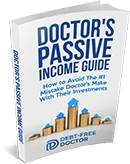What Are Closed-End Funds? A Simple Guide to CEFs
I’m constantly on the lookout for passive income opportunities for members of my Passive Investors Circle.
And one of the easiest ways to do this is by tapping into the low-hanging fruit most people already have: a stock market portfolio.
Let me explain…
Most investment portfolios are set to “growth” mode. For example, up until a few months ago, 98% of my personal holdings were in index funds tracking the overall stock market and the S&P 500. Now, there’s nothing wrong with this approach if you want growth and have plenty of time to let your money sit and compound.
But I’ve reached the point where I want cash flow now, not later. That’s when I stumbled onto something called a closed-end fund.
Closed-end funds (CEFs) might seem mysterious at first glance, but they offer unique ways to build wealth and work toward financial independence.
For investors looking to diversify their portfolios beyond traditional mutual funds, understanding CEFs can unlock new income streams, strategic asset allocations, and exposure to specialized sectors.
Let’s dive in.
Don’t Miss Any Updates. Each week I’ll send you advice on how to reach financial independence with passive income from real estate.
Sign up for my newsletterWhat Are Closed-End Funds?
A closed-end fund is a type of investment company that issues a fixed number of shares through an initial public offering (IPO). After that, those shares trade on the secondary market (the stock exchange), similar to stocks. You don’t buy or redeem shares directly from the fund after launch.
Unlike open-end mutual funds, which create or buy back shares as needed, CEFs are “closed” — no new shares are created after the IPO unless they do a secondary offering. This fixed structure allows managers to focus on longer-term investment objectives without worrying about cash inflows and outflows.
I first learned about CEFs after reading The Income Factory by Steven Bavaria.
Some of his favorite companies he invests in:
- Nuveen
- BlackRock
- PIMCO
- Eagle Point Income
- KKR Credit Advisors
- Cornerstone
Related: How to Build Monthly Income with Steven Bavaria’s Income Factory
Why This Structure Matters
Because there’s a set number of shares, the fund’s market price can trade at a premium or discount to its net asset value (NAV) — the value of all fund assets minus liabilities. This price movement reflects current market sentiment, not just the actual value of underlying investments.
You might see CEF shares trading at a discount to NAV, which some investors see as a deal. But make sure you have complete information on why that discount exists — it could be due to poor past performance, high fees, or risky strategies.
Leverage and Risk
Many closed-end funds use leverage, meaning they borrow money to buy more assets and potentially boost returns (or total return). Leverage can increase your net investment income, but it also introduces higher risk, especially in volatile markets.
It’s similar to using extra weights in the gym: you can grow faster, but you might get hurt if you don’t know what you’re doing. 🙂
Income Distributions and Tax Treatment
CEFs often appeal to investors looking for income, such as retirees (early retirees) or those looking to reduce active income. Many focus on regular distributions, which may be monthly or quarterly.
These distributions can include interest, dividends, capital gains, or return of capital (ROC). ROC means part of what you receive is your original investment coming back to you — important to understand because it affects your tax treatment and future investment return.
Always check a fund’s summary prospectus, fund’s website, or press releases for detailed breakdowns. Your tax advisor or financial advisor can help you understand the tax consequences and whether these distributions fit your goals.
Investment Strategies and Asset Classes
CEF managers can pursue a range of investment strategies, including:
-
Municipal bond funds for tax-free income in the United States
-
Real estate funds for income from commercial properties
-
Preferred stock strategies
-
Global equity or exchange-traded funds (ETFs) hybrids
-
Fixed-income plays like corporate or high-yield bonds
CEF managers often have more freedom to invest in niche or illiquid assets because they don’t have to worry about daily redemptions. This flexibility lets them chase specialized opportunities, which is why you’ll often see them dive into unique sectors or emerging markets.
Important Considerations Before You Buy
When you’re evaluating a closed-end fund, you need to look beyond the headline yield. Here are a few things to watch:
-
Investment objectives: Does this fund match your goals — income now, growth later, or both?
-
Performance data: Look at three-year history, fund’s investment performance, and historical distribution sources.
-
Fees: Review expenses net of fund expenses since they can eat into returns.
-
Leverage level: How much are they borrowing to boost yields?
-
Liquidity and trading volume: Some CEFs trade thinly, affecting your ability to buy or sell at current prices without big swings.
Also, check if the fund uses reinvestment of distributions — some investors like to take cash; others prefer to compound.
The Role of Advisors and Regulations
CEFs operate under the Investment Company Act of 1940, just like mutual funds. However, they’re structured differently.
A good investment advisor or registered investment advisor (RIA) can help you understand risk factors, fees, and if the fund is appropriate given your financial situation. Advisors operate in a fiduciary capacity, meaning they must act in your best interest (at least the good ones do).
You’ll also see that most CEFs clarify they are not bank guaranteed, FDIC insured, or offering any guarantee of future results.
Market Price vs. NAV
Unlike open-end mutual funds, CEFs have a fund’s shares price set by the market — this is the fund’s market price, which might differ from its NAV.
A premium happens when investors pay more than NAV, and a discount when they pay less. Some investors love hunting discounts, but remember: discounts exist for reasons.
Always gather detailed information, including the fund’s distribution rate, investment objectives, and risk factors, before jumping in.
Who Might Like CEFs?
CEF shares aren’t just for retirees. Younger investors who want to build passive income early, diversify into real estate funds or specialty bonds, or focus on total return might also like them.
Institutional investors and big family offices sometimes use CEFs to complement open-end funds and ETFs for a more active or specialized allocation.
Key Disclosures and Warnings
Always remember:
-
You can lose money (there’s possible loss).
-
There is no bank guarantee or guarantee of future results.
-
Check investment products, asset class breakdowns, and specific objectives.
-
Read summary prospectus or fund’s website for complete information and additional information.
-
Past performance is not indicative of future results.
Final Thoughts
If you’re tired of watching your investments only on a screen without ever seeing a dime in your bank account, closed-end funds might be worth a look.
They won’t be a good fit for everyone — they come with higher risk, require more homework, and prices can swing around. But for folks looking for real passive income, potential discounts, and specialized exposure, CEFs can be a great addition.
Make sure your financial advisor or tax advisor helps you dig into all the details — from current performance to tax implications and investment objectives. Once you understand them, you might find CEFs to be an exciting way to make your money work for you today, not just decades down the road.



